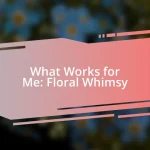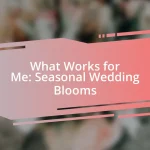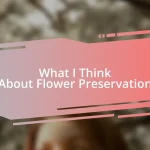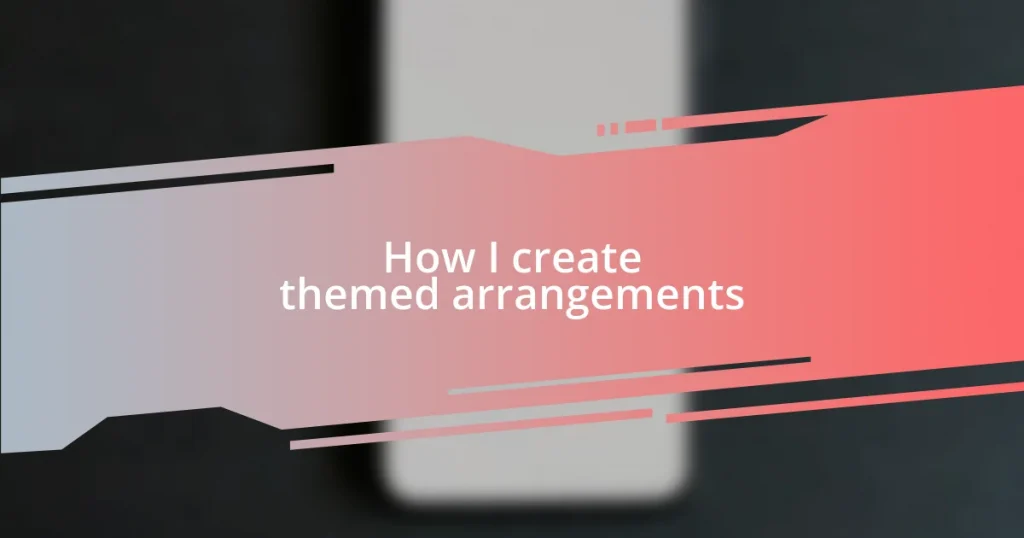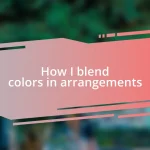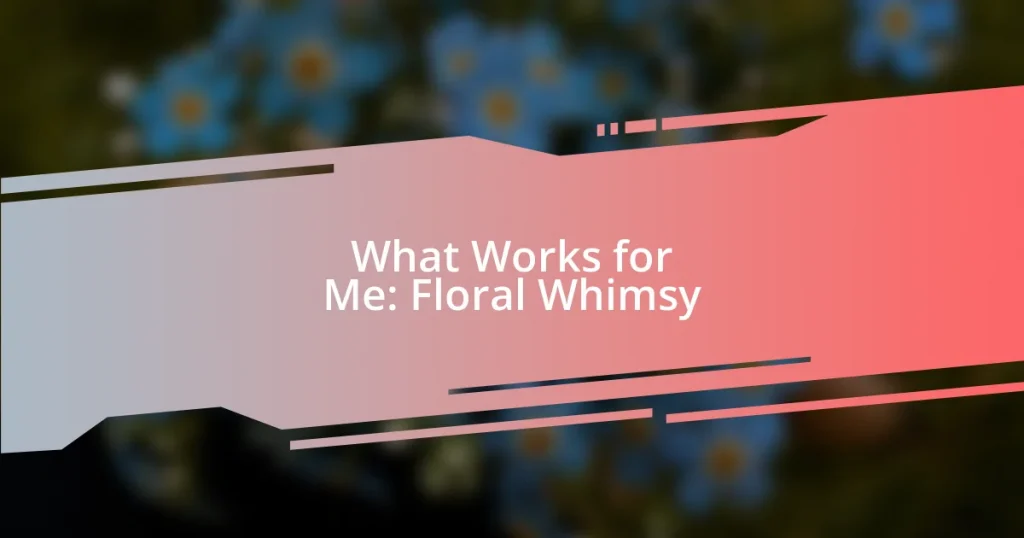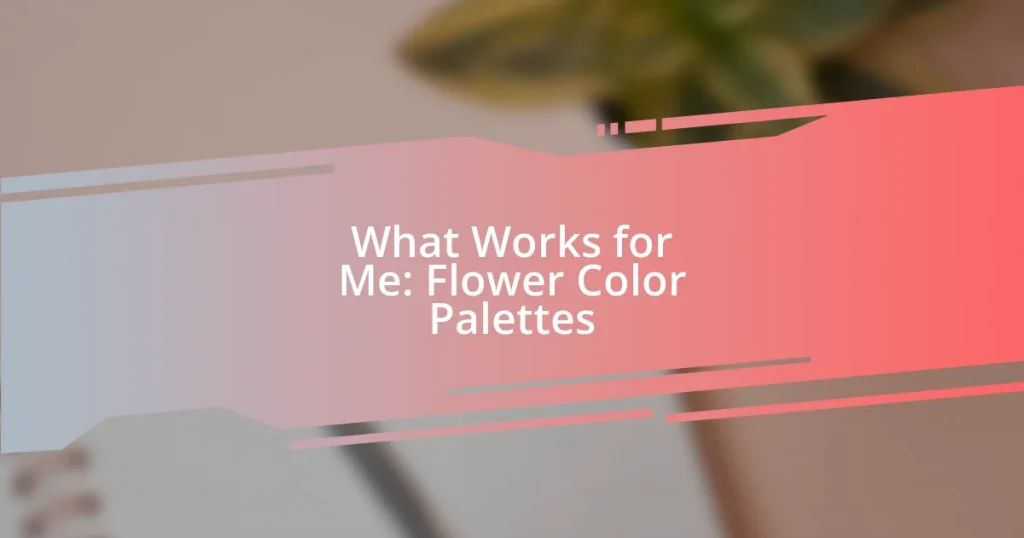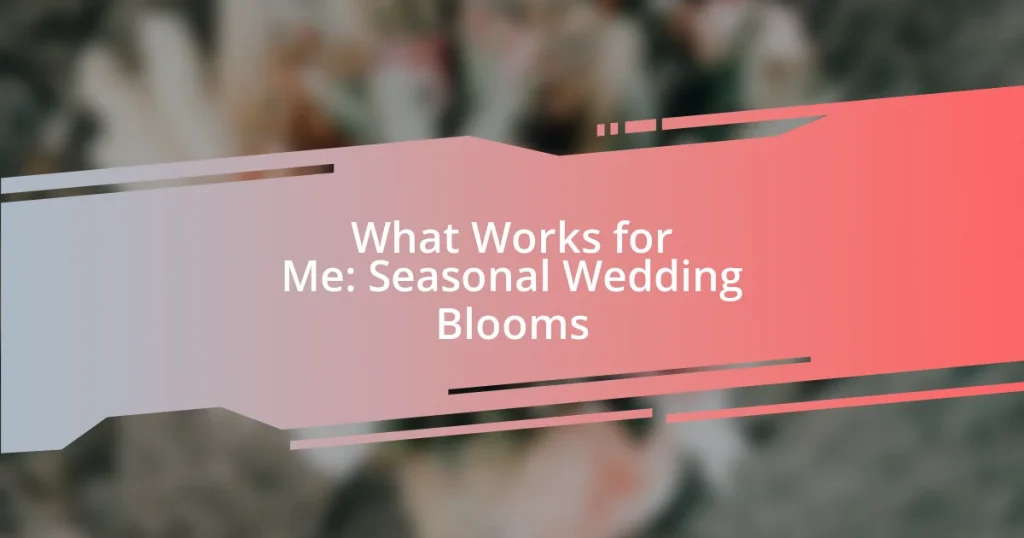Key takeaways:
- Selecting a theme for arrangements should reflect personal emotions and the occasion, enhancing the overall experience for guests.
- Understanding color psychology is essential as colors evoke specific emotions that can influence the atmosphere of an arrangement.
- Incorporating textures, patterns, and thoughtful details can transform arrangements, making them visually engaging and emotionally resonant.
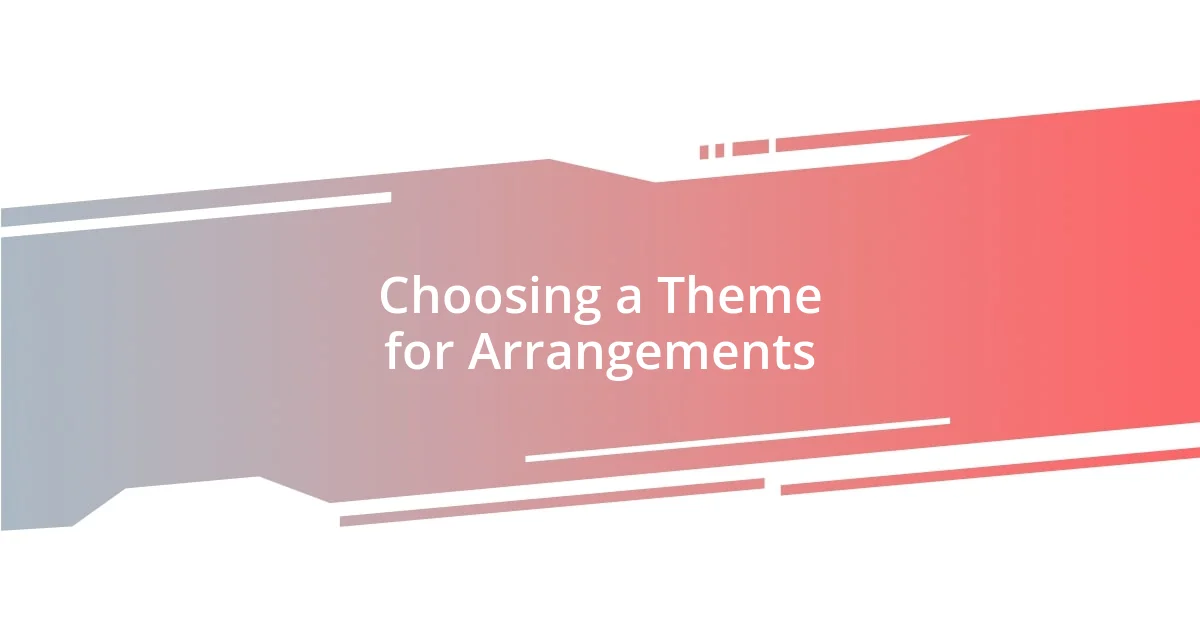
Choosing a Theme for Arrangements
Choosing a theme for arrangements can be a deeply personal experience. I recall the joy I felt when I decided to base my last arrangement on the colors of a sunset; it inspired me to use deep oranges and soft purples, creating a warm and inviting atmosphere. Isn’t it fascinating how a simple theme can evoke such strong emotions and memories?
When selecting a theme, I often ask myself what message I want to convey. A rustic theme might remind guests of a cozy cabin retreat, while a vibrant, modern theme could energize the room. There’s something special about aligning the essence of your arrangement with an experience or emotion that resonates with you.
Also, I find that considering the occasion plays a crucial role in theme selection. For example, I once created an arrangement for a wedding that emphasized love and unity by using intertwined flowers that symbolized togetherness. How do you want your guests to feel when they see your arrangement? Tailoring your theme can transform a moment from ordinary to unforgettable.
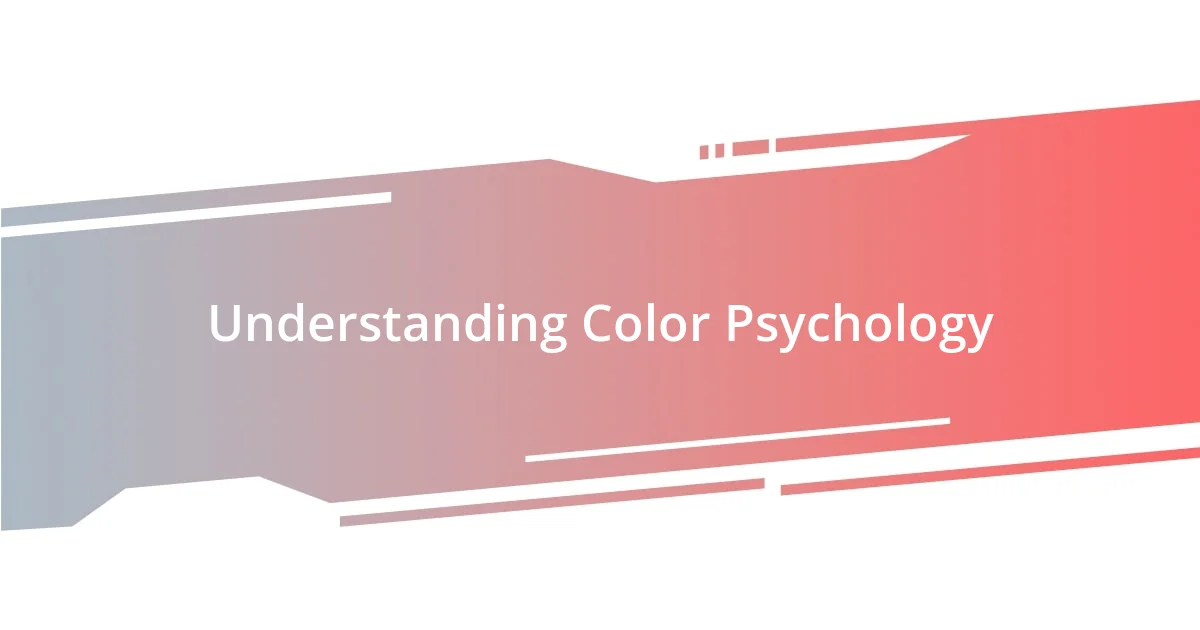
Understanding Color Psychology
Understanding Color Psychology influences how we perceive beauty in arrangements. I remember when I chose a bright blue and yellow palette for a summer garden party. The yellow flowers burst with joy, while the blue tones brought a calming effect, creating a delightful balance. It was incredible to see how the colors energized my guests and sparked conversations.
The impact of color extends far beyond aesthetics; each hue carries psychological connotations that can enhance the atmosphere. For instance, using green can evoke feelings of renewal and tranquility, perfect for a relaxing space. I often consider the emotional responses I want to inspire. When I curated an autumn-themed arrangement with rich reds and warm browns, it created a cozy, inviting ambiance reminiscent of cherished family gatherings around the fireplace.
Ultimately, understanding color psychology requires paying attention to how colors interact with one another and the emotions they can evoke. On my last project, I experimented with contrasting colors to draw attention and create a dynamic arrangement. It was thrilling to witness how strategic color choices could shift the mood and energy of a gathering.
| Color | Emotion/Response |
|---|---|
| Red | Passion, Energy |
| Blue | Calm, Trust |
| Yellow | Happiness, Optimism |
| Green | Renewal, Tranquility |
| Purple | Luxury, Creativity |
| Orange | Warmth, Enthusiasm |

Selecting Appropriate Materials
When I’m selecting materials for my themed arrangements, I often reflect on the textures and elements that will enhance the overall theme. For instance, I remember creating a beach-themed arrangement once. I collected shells, sand, and driftwood, which not only brought the theme to life but also transported me back to sunny days spent on the shore. The tactile experience of these materials allowed my guests to connect with the arrangement on a deeper level.
Here are some key factors I always consider when selecting materials:
- Texture: Different textures add depth. Think about combining smooth stones with rugged bark to evoke a natural feel.
- Color Compatibility: Ensure materials align with your chosen color palette. The right colors can elevate the theme significantly.
- Symbolism: Choose items that resonate with the theme. For example, lanterns can symbolize guidance and warmth, perfect for a cozy fall arrangement.
- Sustainability: I prefer eco-friendly materials when possible. They not only minimize environmental impact but also add a story to the arrangement.
- Personal Significance: Incorporating items with sentimental value, like a piece of fabric from a loved one’s event, can deepen emotional connections.
Each material plays a role in telling the story of the arrangement, making it not just a visual delight, but an emotional journey.
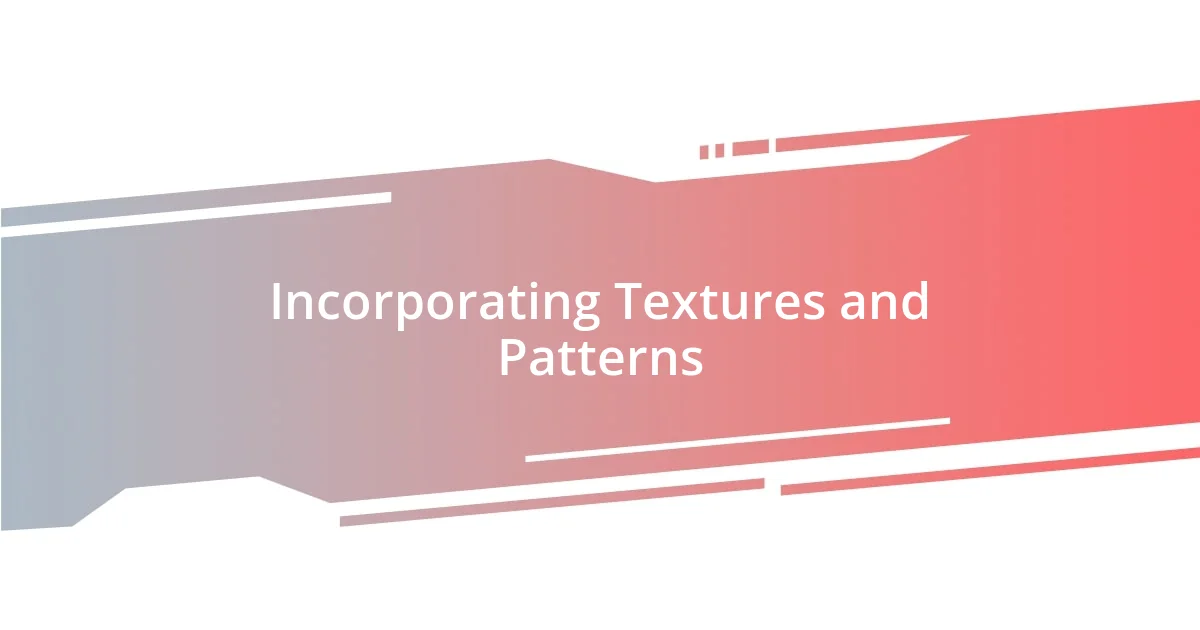
Incorporating Textures and Patterns
In my experience, incorporating different textures creates a captivating visual and tactile experience that draws people in. I love layering soft, velvety fabrics with rough, organic elements like twigs or stones. This contrast not only invites touch but also encourages guests to explore the arrangement more closely, sparking conversations about their favorite materials and experiences. Isn’t it fascinating how touch adds another layer to aesthetics?
Patterns can play a significant role in enhancing the theme of an arrangement. I remember designing a vintage-inspired display for a friend’s wedding, where I combined delicate lace patterns with bold stripes. The interplay of these elements created a unique rhythm that echoed the couple’s love story—classic yet vibrant. Patterns can tell a story, and I often ask myself how I can weave these narratives into my arrangements.
Furthermore, I think about how textures and patterns interact with light. For instance, I once used a shiny, reflective vase alongside matte finishes, which created a dance of light throughout the arrangements. It made the entire setup feel alive and dynamic! Have you ever noticed how a simple change in texture can affect the ambiance of a space? By playing with these elements, I find that I can transform the overall mood and engage my audience on multiple sensory levels.
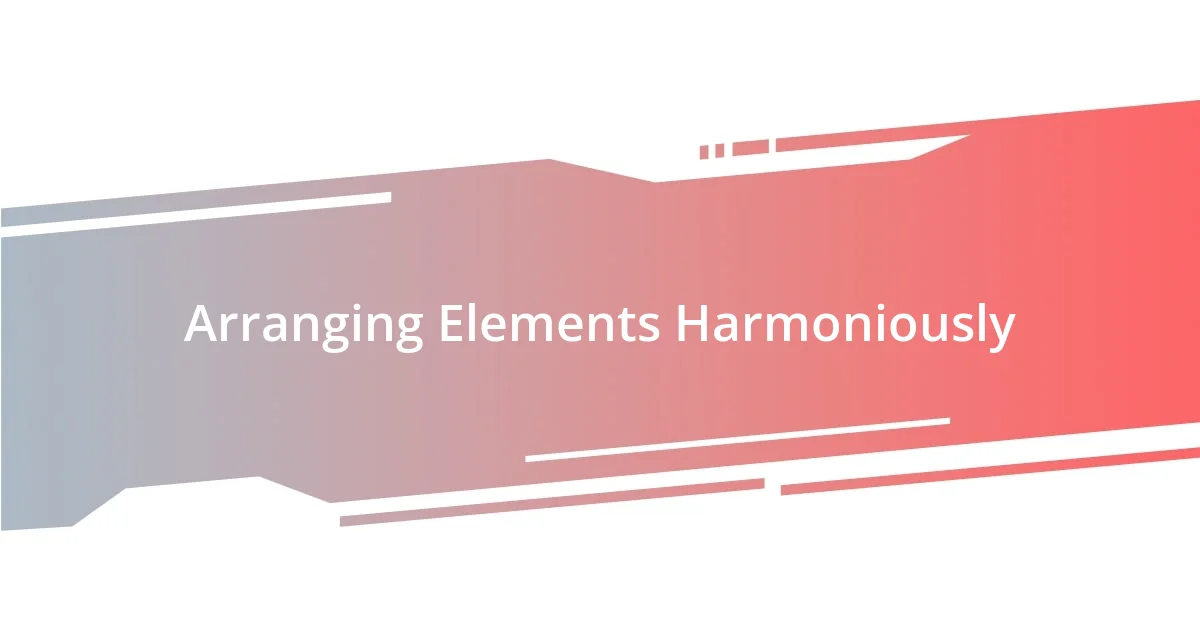
Arranging Elements Harmoniously
When it comes to arranging elements harmoniously, I often think about balance. For example, during a spring-themed gathering, I placed vibrant tulips next to delicate cherry blossoms. The contrast not only made each flower stand out but also created a sense of unity, reflecting the energetic and gentle nature of spring. I find myself asking, how do we create balance in our lives as well? Just like in arrangements, it’s about harmonizing the bold with the subtle.
I also believe that the placement of elements can significantly affect the overall feel of the arrangement. One time, I crafted a cozy winter display with pine branches, candles, and soft fairy lights. The warmth of the lights against the earthy tones of the pine created a sense of comfort and nostalgia, reminiscent of family gatherings around a fireplace. It’s amazing how a simple shift in position can evoke such strong emotions. Do you think about how placement impacts your space?
Finally, integrating a varied scale of items in an arrangement can draw the eye and create visual interest. I recall a beach-themed centerpiece where I mixed small seashells with larger pieces of driftwood. The juxtaposition encouraged guests to explore the arrangement, making it an interactive experience. I often ponder how our guests interact with the spaces we create. Are they simply observers, or do we invite them to truly engage with the story behind each element? By arranging thoughtfully, I strive to make sure they feel a connection to the theme, creating a shared experience.
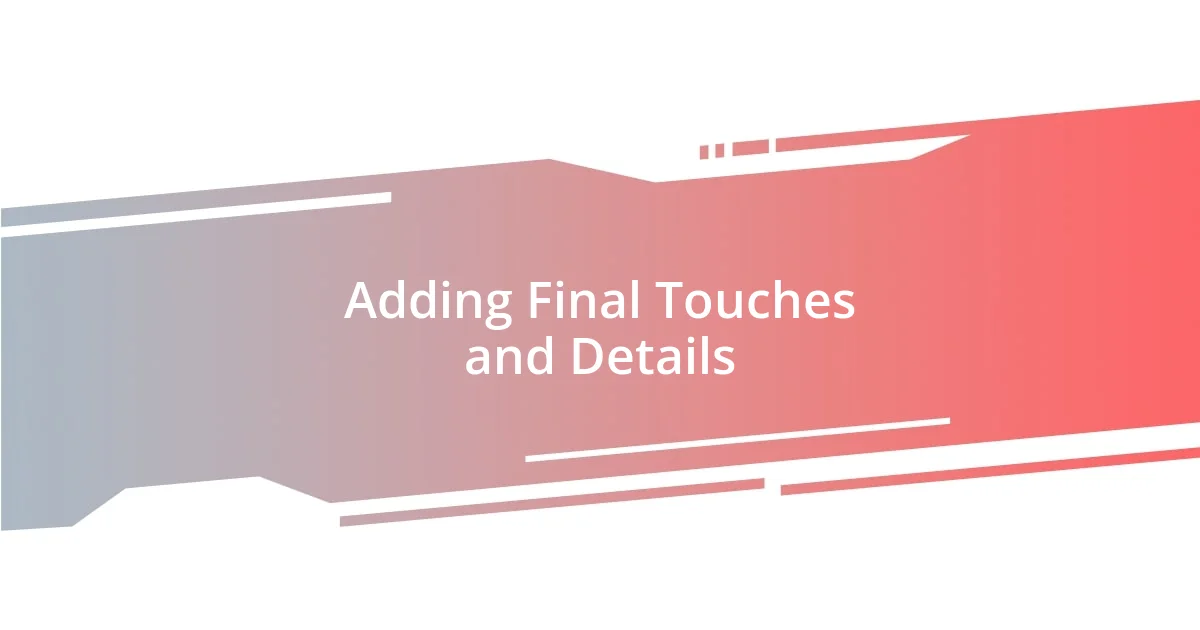
Adding Final Touches and Details
When adding the final touches, I find that small details can make a world of difference. For instance, I once spruced up a summer picnic arrangement with hand-painted wooden signs that pointed guests to various treats. The playful touch didn’t just add charm; it sparked laughter and conversations among everyone. Have you ever noticed how little elements can turn an already lovely arrangement into a memorable experience?
I also love incorporating seasonal elements as finishing touches. I remember a cozy fall display where I tucked tiny pumpkins among the decorative pieces. These vibrant pops of color not only highlighted the autumn theme but also evoked that warm, nostalgic feeling we all have about this time of year. It’s fascinating to witness how such simple additions can resonate emotionally and bring folks together. What seasonal symbols do you connect with?
Finally, I believe that lighting plays a pivotal role in the final presentation. I once set up an evening gathering with an array of candles flickering softly at different heights. The warm glow transformed the arrangement into something magical, inviting guests to relax and linger longer. Do you agree that the right lighting can create an entirely new atmosphere? By thoughtfully considering these final details, I truly enhance the experience, leaving a lasting impression on everyone who steps into the space.

Evaluating Your Themed Arrangement
Evaluating a themed arrangement can be both an art and a thoughtful process. I often step back and observe how the elements interact. Recently, I created an autumn-themed table setting with rich oranges and deep browns. As I assessed it, I realized that while the colors were beautiful, the arrangement felt a bit flat. It hit me then—layering textures, maybe a few rustic elements like burlap or some acorns, could elevate the whole display. Isn’t it interesting how a single observation can spark a wave of inspiration?
Another aspect I focus on is the emotional response the arrangement evokes. During a winter celebration last year, I noticed that guests gravitated toward a cozy corner where I had displayed a warm color palette alongside twinkling fairy lights. The atmosphere felt inviting and sparked many heartwarming conversations. I often wonder—how do you want your guests to feel when they walk into your space? By considering these emotional triggers, I aim to shape moments that linger in the minds of my friends and family.
Finally, I find that feedback is immensely valuable. After hosting a vibrant summer gathering, I asked my friends what elements they enjoyed most. They highlighted the fiery floral arrangements and the playful touches of pineapple decor. This interaction made me realize how important it is to listen to others’ perspectives. It leaves me curious—how often do we seek feedback to improve our own creations? By engaging with others, I can refine my approach and create themed arrangements that resonate more deeply with everyone involved.
